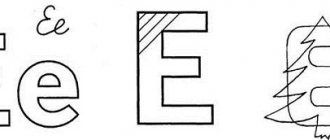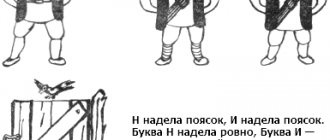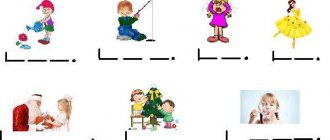Today I would like to talk about the very first games for teaching reading. They are suitable, first of all, for children who still cannot read at all ( you can play from 1.5-2 years old ), but, of course, they will also be useful for those who have already learned a little continuous reading.
I want to say right away that there will be no games here like coloring and modeling all the letters of the alphabet in turn from plasticine. In my previous article, I already wrote that a child who has memorized individual letters using the alphabet or in any other way subsequently experiences many difficulties in combining them into syllables. Therefore, I want to invite you to play not with letters, but immediately with words (MI, BUT, TU...) and short words. With this approach, the child constantly sees ready-made letter combinations before his eyes, plays with them, rearranges them, and, as a result, quickly remembers them . At first, only visually, then he tries to reproduce it himself. As a result, the child does not experience problems with merging letters; he immediately reads the letter. But, interestingly, during such games the child remembers all the letters.
What do you need for games?
So we will play:
- with warehouses (not to be confused with syllables)
The concept of a warehouse was introduced by Nikolai Zaitsev (creator of the well-known Zaitsev cubes). Unlike a syllable, which can consist of either 4 or 5 letters, a warehouse is considered a minimally pronounceable unit. The warehouse can be:
- fusion of consonant and vowel (YES, MI, BE...);
- a separate vowel as a syllable ( YA -MA; KA- YU -TA);
- a separate consonant in a closed syllable (KO- SH -KA; MA-YA- K );
- consonant with a soft or hard sign (Мь, Дъ, Сь...).
In the game you can use both Zaitsev's cubes and cards with warehouses written on them. I’m not going to try to persuade you to buy expensive Zaitsev cubes now. Yes, this is an interesting and useful manual, but if you do not have the opportunity to purchase them, do not worry, you can make a huge number of manuals at home with only cardboard and markers.
- with words written according to the warehouse principle.
You can either write words by hand with a felt-tip pen or print them on a printer. So that the child sees not only the whole word, but also learns to analyze its composition, we will highlight warehouses in it. It is not advisable to separate warehouses using additional signs (separate them with dashes, circle them); it is best to highlight them in different colors. You don’t need to use all the colors of the rainbow; take two colors that are similar in shade, for example, blue and cyan or dark green and light green. You will also need black. We write the first warehouse in one color, the second in another, the next one in the first color again, etc. But! The shock warehouse is always highlighted in black, as it is heard “brighter”.
What words should I write on the cards?
- short (at first no more than 3-5 letters),
- simple (preferably consisting of frequently used letters, Ш and ъ will wait for now),
- familiar and interesting to the child.
The main essence of this approach to teaching reading is to show the child that letters and words are not meaningless squiggles, they represent very specific objects, and you can play with them just like with familiar toys.
Didactic games for teaching reading to children 5-7 years old
Didactic games and exercises for teaching reading.
Didactic games and exercises for teaching reading to preschool children using information technology.
Author: Kraenkova Nina Nikolaevna, teacher of additional education of Central Television and Radio, Krasnoyarsk. Purpose of the work: didactic games are intended for children of senior and preparatory groups of kindergarten, additional education teachers, and parents. Goal: To create motivation in children to study at school. Objectives: 1.Develop cognitive activity. 2.Consolidate knowledge of letters and sounds. 3.Activate vocabulary 4.Cultivate the desire to achieve a positive result. Job description: Modern information technologies make reading learning accessible and interactive.
The child not only sees vivid, memorable images, but can also actively interact with the educational program. These games are aimed at creating motivation in the child to study at school. In exercises - games with letters, children repeat and consolidate their knowledge of letters and sounds, remember the spelling of printed letters - their image. The use of these games involves the development of logical thinking, memory, imagination, creativity, and curiosity in children aged 5-7 years. Exercises and games for teaching reading and memorizing letters are designed taking into account age characteristics and have different levels of difficulty. Some children cannot complete all tasks the first time. You can skip the task that caused difficulty and return to it later. Also, these games allow you to determine what causes difficulties for a child and individually select appropriate materials and exercises for him. Indeed, in preschool age, the level of development of a child often depends on who, how and how much works with him. There are several types of tasks in exercises - games with letters and syllables. The tasks use words well known to the child, consisting of 2-3 syllables. Syllables consist of two letters, a vowel and a consonant. As a rule, the child does not have any difficulties completing such tasks. Assignments can be supplemented at the discretion of the teacher. Game 1.
Fill in the missing letter and read the words.
Game 2.
Connect the syllables to form the word shown in the picture.
Game 3.
Connect the syllables with arrows and name what you get in one word.
Game4.
Make words from letters.
Game 5.
Make up the names of two flowers using letters.
Game 6.
Read the sentence, complete the words.
We recommend watching:
Games to develop the emotional sphere of a preschooler When is a child ready to read? Is your child ready to learn to read? Why can't a child learn to read?
Similar articles:
Alphabet learning games for children 4-5 years old
On the role of play in the development of preschool children
Functions of a didactic game for preschoolers
Basic principles of games
There is one very sure way to discourage a child from reading - this is to constantly test him: “Tell me, what letter is this?”, “Read what is written here!” Having shown a letter to a child a couple of times, we expect that by the third time he will already name it, or even better, read the word with its participation. If you want to really interest your child in reading, then put off at least for a while trying to examine your child and just read with him!
It is natural that a child just beginning to become familiar with the world of letters cannot read a word. Therefore, when showing words to your child, do not require him to read, but at first read for him yourself! You can also trace the letters with your baby’s finger. After some time, the child will definitely begin to recognize words and phrases and will repeat them after you.
Sometimes a word needs to be read slowly, highlighting each word in it, sometimes it is necessary to name the entire word so that the baby learns to perceive the words as a single whole.
While reading, you can name individual letters (for example, if you don’t like the warehouse approach), but in this case it is advisable to pronounce not the name of the letter (“el”, “ka”), but the sound that corresponds to this letter (“l”, "To").
Didactic aids for teaching preschoolers 5-7 years old to read and write
Didactic aids for teaching preschoolers literacy in kindergarten
Author: Tatyana Vladimirovna Mikhailova, teacher at MBDOU "GDS" Skazka" Volgorad region, Gorodishche village
Description of work: these manuals may be of interest to teachers when teaching older preschoolers to read and write.
There are a lot of didactic games for speech development. Among these games we can highlight house games in which sounds live. There are quite a lot of them. But each author of such a manual approaches the creation of his own house creatively and uniquely. My “House of Sounds” is very helpful in teaching reading to older preschoolers. House of sounds.
Goal: development of phonemic hearing and phonemic perception in preschoolers. Objectives: teach children to correlate sounds and letters; develop the ability of preschoolers to identify vowel sounds, distinguish between hard and soft consonant sounds; stimulate children's interest in sounds; enrich their vocabulary, cultivate a love for Russian speech. The manual is made in the form of a cardboard house. This house is magical. Letters and sounds live in it. The manual can be easily transported to the place needed by the teacher. Any words can be placed in this house. But it seems to me that a word should not contain more than five letters, since very long words can contribute to the loss of interest in such difficult work for preschoolers. The letters that make up this word “live” on the first floor. Sounds “live” on the second floor. We represent sounds with cards. Red cards correspond to vowel sounds, blue cards correspond to hard consonants, and green cards correspond to soft consonant sounds.
The teacher or child “populates” the house, and the rest of the children at this time work with multi-colored cards at the tables. (Before class, each child is given a set of cards of three colors.) For example: Educator:
Guys, the word “GAME” has “settled” in our house.
What is the first sound you hear in this word? Children
and].
This sound drags on for a long time, sung. This means it is a vowel and is indicated in red. Take the red card and insert it into the window above the first letter. Educator:
What is the next sound we hear?
Children:
[g].
This sound is a consonant and is pronounced firmly. We take the blue card and place it above the second letter. Educator:
Let's say the third sound.
Children:
[r].
This sound meets an obstacle in the mouth, which means a consonant. It's solid. We take a blue card and place the sound [p] above the third letter. Educator:
Let's look at the fourth letter and pronounce the sound.
Children:
[a].
This sound drags on for a long time, sung. This means it is a vowel and is indicated in red. You can complicate the task if the level of knowledge and skills of the children allows it. For example, introduce children to stress and invite them to “strike” the vowel that is “sung” without distorting the word. Preschoolers really like to experiment with sounds. Educator:
Let's “hit” the vowel sound [and]
Children:
It will turn out to be “IIIIIIGame.”
This is not the way to say it. Educator:
What if we highlight another vowel sound [a] with our voice?
Children:
It will turn out to be “gameAAAAAA”. Sounds right. This means we put the emphasis on the letter a.
In my work, when teaching older preschoolers to read and write, I use a didactic manual
"Colored Paths"
Goal: teaching children of senior preschool age to read. Objectives: teach children to correlate sounds and letters, merge sounds into syllables, develop phonemic awareness, cultivate patience and perseverance. The manual consists of a pocket into which a consonant is inserted. Multi-colored paths extend from this pocket. At the end of each path there are vowel letters. Educator:
we run along the red carpet, look at the letter and pronounce the sound
Children:
[t].
Educator:
running our eyes along the path, pronouncing the sound [t], we prepare our sponges for the next sound and pronounce it.
Children:
that
Teacher:
we run along the green path
Children:
that And so, first together, and then in turn, each child practices reading syllables. First from consonant to vowel, then vice versa. This manual helps preschoolers make an intuitive discovery: sounds merge to form syllables and words. Not all paths in the photo are filled. This place is reserved for iotized letters, which my guys will learn about a little later.
We recommend watching:
Scenario of a game program for teaching literacy to children in the preparatory group Didactic game for teaching literacy to older preschoolers Didactic game for teaching literacy to older preschoolers Notes on teaching literacy in the preparatory group
Similar articles:
Summary of a lesson on teaching literacy in the preparatory group
Summary of a lesson in the preparatory group on the development of speech and literacy
Literacy games for children 4-5 years old
Literacy games for children 5-6 years old in kindergarten
Educational games for children 6-7 years old in kindergarten. Card index





